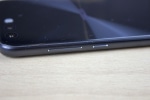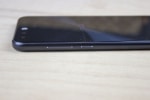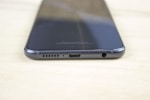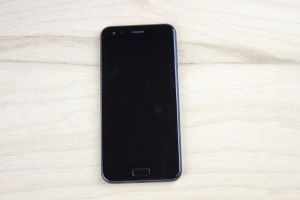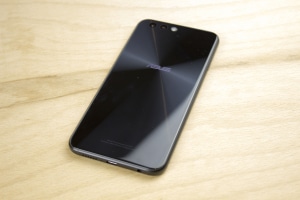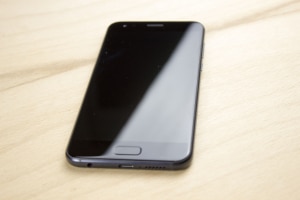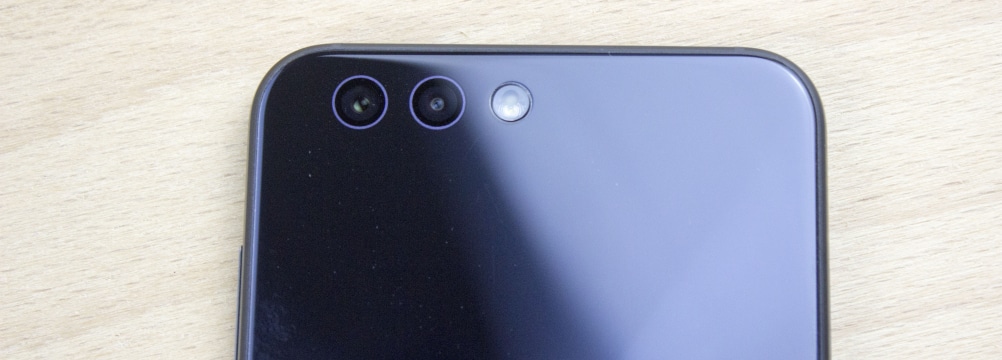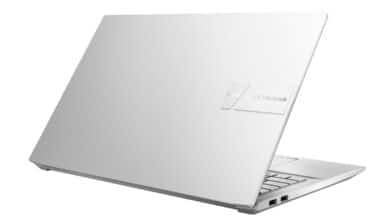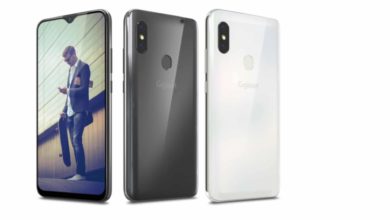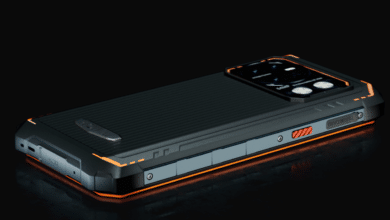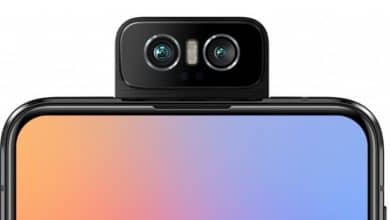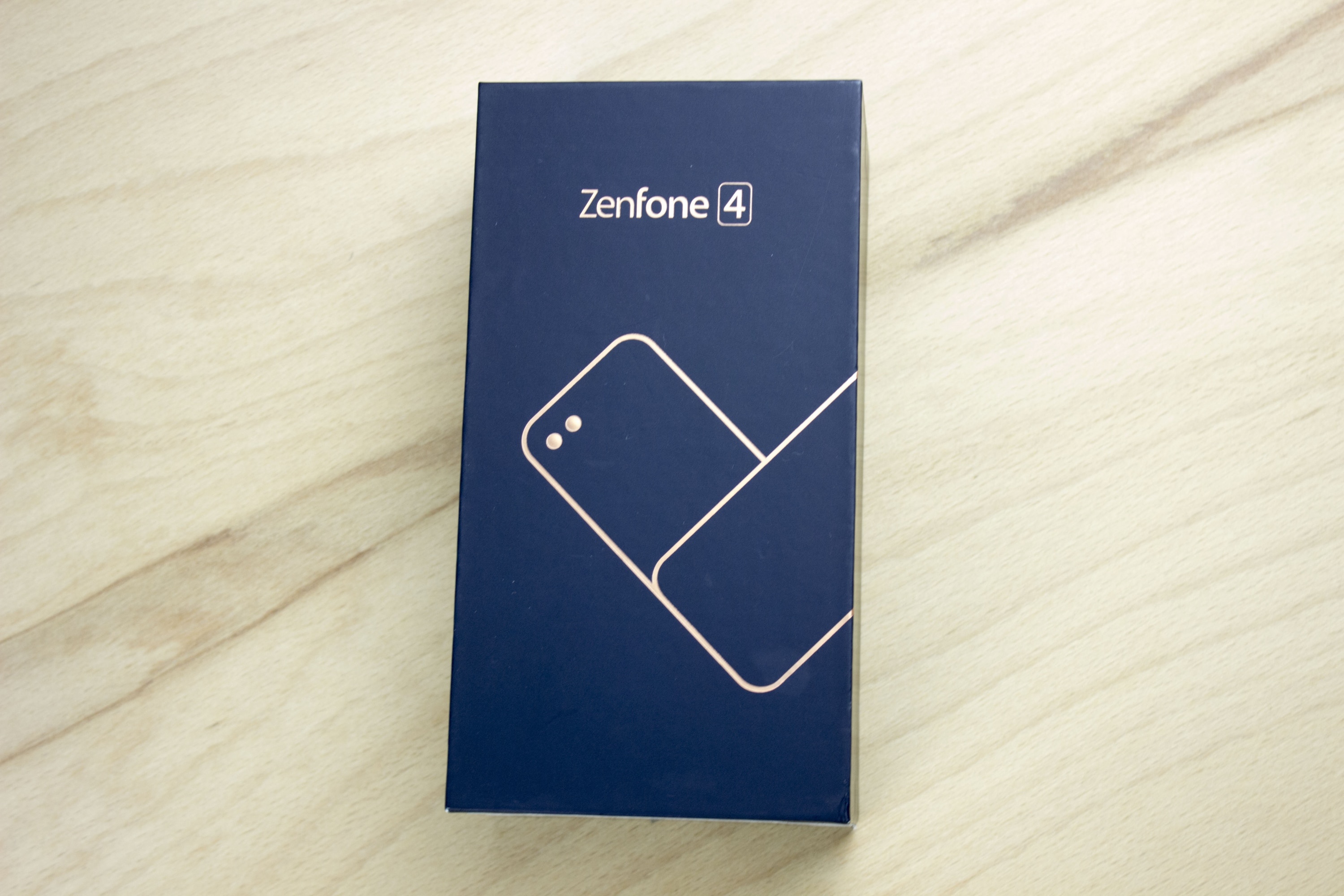
With the ZenFone 4 the Taiwanese manufacturer Asus brings a smartphone of the upper middle class to Germany, which comes along with a chic design and interesting features. These include, for example, a wide-angle camera and Hi-Res audio. In this test you will find out whether the device has a chance on the threshold to the upper class in the highly competitive market.
Design and Workmanship
The design of the ZenFone 4 differs greatly from many competing products, especially on the back. This consists of 2.5D gorilla glass, which has light effects similar to the reflections of a CD when moving. That looks very chic, but it’s very prone to fingerprints. Otherwise, the back is kept extremely simple, only the rear cameras and flash sit in the upper left corner. The back is completely flat, not even the cameras stand out from the glass. That may look good, but to pick up a smooth table top is in my experience rather impractical. Because the device is very thin, it’s not as easy to grip as smartphones with a less smooth surface.
The frame of the ZenFone 4 is completely made of aluminium and feels very high-quality. On the right side you’ll find the on/off button and the volume rocker, and on the bottom you’ll find the USB-C port, speakers and a 3.5 mm jack socket.
Let’s move on to the front. The display is of course on this one, which is rather large at 5.5 inches. The edges above and below the display are unfortunately very thick, so that the smartphone is very high overall. Clear edges are also visible on the screen pages. That the ZenFone 4 is not advertised with a borderless display is clear to me, but nevertheless the edges seem a bit too massive in my eyes. Asus offers three Android buttons on the underside, whereby the home button has an integrated fingerprint sensor. I myself use a smartphone with a sensor on the back, so it was hard for me to get used to unlocking with my thumb. In principle, however, the sensor works very well. I am also unaccustomed to the fact that the Home button is there, but cannot be physically pressed. Instead he reacts, like the other Android buttons, to touch.
I like the workmanship of the ZenFone 4 very much. Asus uses high-quality materials such as scratch-resistant 2.5D gorilla glass and aluminium. The gap dimensions are very small and the buttons have good and clearly defined pressure points. The only pity is that the entire device is extremely susceptible to fingerprints. It is clear that this cannot really be prevented with glass, but it is particularly noticeable in the minimalist design of the ZenFone.
The scope of delivery includes, in addition to the device itself, a mains adapter, a USB-C cable, as well as earphones and a short manual.
Display
The display of the Zenfone 4 is 5.5 inches large and resolves with FullHD (1,920 x 1,080 pixels). It convinces with strong colours and a good viewing angle stability. Also the maximum brightness of 600 nits is very decent. This means that working with the smartphone is no problem even in bright environments.
The pixel density is about 400 ppi. This is not outstanding, but completely sufficient and a standard value for mid-range smartphones, as well as some high-end devices. The pixel density is high enough not to be able to recognize individual pixels anymore. In addition, the fact that you don’t need a higher resolution saves you money and also the battery: the display resolution is one of the biggest enemies of battery life. This is one of the reasons why even the Huawei Mate 10 Pro offers no better pixel density.
All in all, I am convinced by the display of the Zenfone 4, even though the somewhat generous screen edges are a thorn in my side. But maybe I am only too spoiled by the rimless screens of other manufacturers.
Hardware
| Display | 5,5 inch Super Wide-View |
| resolution | Full HD (1920 x 1080 Pixel) – 400 ppi |
| Memory | 64 GB, expandable with up to 2 TB |
| RAM | 6 GB LPDDR4 |
| Processor | Qualcomm Snapdragon 630 (Octa-Core) |
| GPU | Adreno 508 (SD630) |
| dimensions | 155.4 x 75.2 x 7.5 mm |
| Weight | 165 g |
| back camera | 12 MP Sony IMX362 Dual Pixel, f/1.8 aperture, OIS, LED flash + 8 MP wide-angle camera, 120° wide-angle |
| Front camera | 8 MP, f/2.0 f-stop |
| Accu | 3300 mAh |
| connectivity | WLAN 802.11a/b/g/n/ac (2.4 GHz + 5 GHz), Bluetooth 5.0, FDD-LTE, TD-LTE, GPS, A-GPS, GLONASS, BDS, GAL, Dual Sim |
| Price | Product |
Multimedia
Camera
The ZenFone 4, like so many smartphones today, has two main cameras. However, the second camera does not have a monochrome sensor or a higher zoom level, as is the case with Huawei or Apple. Instead, Asus uses a wide-angle camera with 120° and 8 megapixels to capture larger image areas. This is very suitable for panorama shots, for example.
Overall, I am satisfied with the camera performance of the ZenFone 4. In low light, however, the photos are quite noisy, especially the wide angle sensor takes rather muddy pictures with low-light. In daylight, however, both sensors take reasonable pictures. The front camera is also fine, but the pictures aren’t really beautiful with it. The camera app from Asus is clearly arranged and offers numerous functions such as HDR, panorama, etc.
The uncompressed images are available for download here.
Music
The Asus ZenFone 4 is Hi-Res Audio certified and supports DTS Headphone:X. This means that the device can output music at up to 192 kHz at 24 bits, which in practice only works with high-resolution music files. Nevertheless, it’s nice to see that Asus apparently attaches great importance to the sound of its product, even the DTS logo can be seen on the boat screen.
In the sound settings, the so-called AudioWizard app, you can make numerous settings to improve and personalize the sound of your smartphone. For example, there are sound profiles that influence the sound of the music depending on the genre. Even the headphones used can be adjusted. It is also possible to go through a test, the aim of which is to adjust the volume of different frequencies in such a way that anatomical differences in listening perception are balanced out and the music sounds as close as possible to the artist’s intentions. In addition, noise cancelling technology from Asus is used to eliminate background noise.
In theory it all sounds pretty good, but is the sound really better than with other smartphones? At first I was a little skeptical. Without further settings I was not really more convinced of the sound than with other devices. But when I started experimenting with the sound settings, I quickly realized how much more sound quality could be gained. Slightly optimized, the ZenFone 4 actually sounds very good and powerful.
The built-in loudspeakers weren’t that bad and Asus includes relatively high-quality earphones, which are also available as a sound profile in the app. Overall, I am very satisfied with the sound quality of the ZenFone 4. If you value good sound, you are definitely well advised to use this device.
Benchmarks
As far as graphics performance is concerned, the ZenFone 4 plays in the middle class. In tests that demand the CPU in particular, the smartphone performs quite well, especially in multi-core mode; in single-core mode, there are already considerably cheaper devices that achieve this performance.
| wdt_ID | Smartphone | OpenGL Manhattan | OpenGL Car Chase | T-Rex |
|---|---|---|---|---|
| 1 | Moto X Force | 11,0 | 7,3 | 42,0 |
| 2 | Neffos C5 Max | 4,4 | 2,1 | 0,0 |
| 3 | UMi London | 0,0 | 0,0 | 7,3 |
| 4 | Gigaset GS160 | 3,4 | 0,0 | 11,0 |
| 5 | Sony Xperia XZ | 46,0 | 20,0 | 59,0 |
| 6 | Kodak Ektra | 9,6 | 0,0 | 35,0 |
| 7 | Huawei Mate 9 | 32,0 | 14,0 | 60,0 |
| 8 | Huawei Nova | 10,0 | 3,6 | 22,0 |
| 9 | BQ Aquaris X | 9,6 | 3,5 | 22,0 |
| 10 | Neffos X1 | 11,0 | 3,9 | 22,0 |
| Smartphone | OpenGL Manhattan | OpenGL Car Chase | T-Rex |
| wdt_ID | Smartphone | Sling Shot | Sling Shot Extreme | Ice Storm Unlimited | Ice Storm Extreme |
|---|---|---|---|---|---|
| 1 | Moto X Force | 1.348 | 0 | 0 | |
| 2 | Neffos C5 Max | 284 | 6.816 | 4.361 | |
| 3 | UMi London | 0 | 2.827 | 1.951 | |
| 4 | Gigaset GS160 | 161 | 3.710 | 2.333 | |
| 5 | Sony Xperia XZ | 2.416 | 0 | 0 | |
| 6 | Kodak Ektra | 1.023 | 15.606 | 9.343 | |
| 7 | Huawei Mate 9 | 2.688 | 29.138 | 13.288 | |
| 8 | Huawei Nova | 461 | 13.637 | 8.091 | |
| 9 | BQ Aquaris X | 847 | 13.986 | 8.335 | |
| 10 | Neffos X1 | 481 | 9.294 | 5.486 | |
| Smartphone | Sling Shot | Sling Shot Extreme | Ice Storm Unlimited | Ice Storm Extreme |
| wdt_ID | Smartphone | Score |
|---|---|---|
| 1 | Moto X Force | 4.115 |
| 2 | Neffos C5 Max | 2.892 |
| 3 | UMi London | 2.475 |
| 4 | Gigaset GS160 | 2.600 |
| 5 | Sony Xperia XZ | 5.550 |
| 6 | Kodak Ektra | 3.975 |
| 7 | Huawei Mate 9 | 6.431 |
| 8 | Huawei Nova | 4.594 |
| 9 | BQ Aquaris X | 4.889 |
| 10 | Neffos X1 | 3.183 |
| Smartphone | Score |
| wdt_ID | Smartphone | AnTuTu Score |
|---|---|---|
| 1 | Moto X Force | 22.297 |
| 2 | Neffos C5 Max | 37.569 |
| 3 | UMi London | 22.297 |
| 4 | Gigaset GS160 | 29.251 |
| 5 | Sony Xperia XZ | 33.943 |
| 6 | Kodak Ektra | 84.997 |
| 7 | Huawei Mate 9 | 139.020 |
| 8 | Huawei Nova | 63.206 |
| 9 | BQ Aquaris X | 66.149 |
| 10 | Neffos X1 | 45.024 |
| Smartphone | AnTuTu Score |
| wdt_ID | Smartphone | Single-Core | Multi-Core |
|---|---|---|---|
| 1 | Moto X Force | 2.719 | 2.618 |
| 2 | Neffos C5 Max | 1.063 | 1.563 |
| 3 | UMi London | 685 | 1.146 |
| 4 | Gigaset GS160 | 820 | 1.298 |
| 5 | Sony Xperia XZ | 3.585 | 3.271 |
| 6 | Kodak Ektra | 2.167 | 3.731 |
| 7 | Huawei Mate 9 | 3.270 | 4.519 |
| 8 | Huawei Nova | 1.433 | 2.661 |
| 9 | BQ Aquaris X | 1.444 | 2.279 |
| 10 | Neffos X1 | 1.205 | 2.164 |
| Smartphone | Single-Core | Multi-Core |
| wdt_ID | Smartphone | Score |
|---|---|---|
| 1 | Moto X Force | 2.803 |
| 2 | Neffos C5 Max | 2.697 |
| 3 | UMi London | 2.162 |
| 4 | Gigaset GS160 | 1.794 |
| 5 | Sony Xperia XZ | 4.569 |
| 6 | Kodak Ektra | 5.869 |
| 7 | Huawei Mate 9 | 7.316 |
| 8 | Huawei Nova | 3.325 |
| 9 | BQ Aquaris X | 3.461 |
| 10 | Neffos X1 | 2.914 |
| Smartphone | Score |
| wdt_ID | Smartphone | Single-Core | Multi-Core |
|---|---|---|---|
| 1 | Moto X Force | 1.115 | 4.376 |
| 2 | Neffos C5 Max | 602 | 2.468 |
| 3 | UMi London | 371 | 1.064 |
| 4 | Gigaset GS160 | 535 | 1.493 |
| 5 | Sony Xperia XZ | 1.626 | 3.872 |
| 6 | Kodak Ektra | 1.648 | 4.053 |
| 7 | Huawei Mate 9 | 1.934 | 5.998 |
| 8 | Huawei Nova | 830 | 3.004 |
| 9 | BQ Aquaris X | 921 | 4.495 |
| 10 | Neffos X1 | 731 | 2.738 |
| Smartphone | Single-Core | Multi-Core |
System & Performance
ZenFone 4 runs Android 7, an update to Android 8 Oreo is already announced. Asus uses its ZenUI 4.0 as the user interface. This looks chic and is fast and easy to use. The overall performance is in the mid-range field, where cheaper smartphones, such as the BQ Aquaris X, can also be found. Nevertheless, the Snapdragon processor handles most tasks smoothly and without problems. It is supported by a proud 6 GB of RAM, which is easily enough for intensive 3D games. All in all, the ZenFone 4 is not a performance high-flyer for its price, but for everyday use the performance is easily sufficient.
Battery
The battery of the ZenFone 4 knows how to convince all along the line. In the PCWork battery benchmark it scores best of all test devices so far. This is made possible by 3300 mAh battery capacity, the limitation to Full HD resolution and a power-saving Snapdragon CPU. Unfortunately, quick charging is not supported and wireless charging is not supported.
| wdt_ID | Smartphone | Score |
|---|---|---|
| 1 | Moto X Force | 549 |
| 2 | Neffos C5 Max | 0 |
| 3 | UMi London | 248 |
| 4 | Gigaset GS160 | 442 |
| 5 | Sony Xperia XZ | 391 |
| 6 | Kodak Ektra | 293 |
| 7 | Huawei Mate 9 | 505 |
| 8 | Huawei Nova | 317 |
| 9 | BQ Aquaris X | 553 |
| 10 | Neffos X1 | 345 |
| Smartphone | Score |
Reception & Voice Quality
Reception and voice quality are very good. All common LTE bands are supported, as well as all WLAN standards (a/b/g/n/ac) with 2.4 GHz or 5 GHz.
Conclusion
The Asus ZenFone 4 is an upper mid-range smartphone that has no major weaknesses. Although the case looks a bit clumsy compared to the rimless devices of the competition, overall it is still handy and also looks chic. The device is well manufactured and the 5.5 inch display convinces all along the line. The hardware is rather middle class, but Asus attaches great importance to multimedia functions, i.e. cameras and audio output. In addition, there is a generously dimensioned rechargeable battery that ensures excellent battery life. The operating system is up-to-date and the Asus interface convinces with performance and elegance. All in all, I like the ZenFone 4 very much, especially for users who often take photos or listen to a lot of music, the device is worth a second look.
Asus ZenFone 4
Workmanship
Hardware
Multimedia
Performance
Battery
Value for Money
Solid middle class
The ZenFone 4's strengths clearly lie in the multimedia sector. But the smartphone does not reveal any other major weaknesses either.
